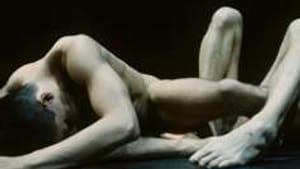Stay in the Loop
BSR publishes on a weekly schedule, with an email newsletter every Wednesday and Thursday morning. There’s no paywall, and subscribing is always free.
Turning the tables on the ‘male gaze'
Jasperse's "Fort Blossom revisited' at Bryn Mawr

For lovers of dance, it's always exhilarating to watch liberated bodies in endless varieties of motion and expression. But the fact remains that dance has long embraced our culture's ingrained body taboos and gender biases that you find in every other art form.
John Jasperse, who takes devilish delight in upending our performance expectations (see for example, my review of last fall's Canyon), confronts, confounds, and transforms us in Fort Blossom revisited (2000-2012), a premiere work with two nude men dancers and two clothed women dancers. The enthralling evening's dance enhances our esthetic acceptance of the body that's been long hidden from the eyes of dance audiences. Within a short hour, Fort Blossom miraculously transforms taboo into anatomical grace.
The work begins with a nude male (Ben Asriel) lying prone downstage, his stunning body lit in a translucent, porcelain white. Sharing his space are two women (Lindsay Clark and Erika Hand), fully clothed in short pale red dresses. They could have come out of the 1971 "Fly Me" campaign of National Airlines, except that they're also attached to large, clear, inflated orange plastic chairs.
Asriel generates pelvic-initiated spinal undulations, each prominently projecting his buttocks and anus, and sensually slithers into the black floor space, where his nude male partner (Burr Johnson) lies upstage with his clear plastic seat. As Clark and Hand begin to explore reclining poses onto their plastic chairs, Johnson rolls on top of Asriel, separated by the inflated plastic.
Women without airy grace?
The men begin, in unison, a rhythmic series of pelvic rolls and hip-swaying movements suggesting a sexual union, as the slowly deflating plastic separation brings them to a still, depleted state— eroticism, pursued and "performed," but undone by the lack of direct, physical intimacy.
Meanwhile, in the other half of the stage, Clark and Hand— attached to inflated backpacks— perform their own unison duet, extending arms and striding in tempered rhythms, disengaging their eyes from those of the audience as they offer their robotic, going-through-the-motions dance.
Does Jasperse want to deflate historic expectations of the woman dancer as the fountain of airy grace through these two women, who sport inflatable backpacks that double their size? If dance, like other art forms, has been burdened with the history of the viewer's "male gaze," the impish Jasperse turns the tables, as Clark and Hand, with their backs to audience, bend over and return the gaze upside down through spread legs.
The dance unfolds into its central scene of a male contact duet where the buttocks, and especially the division between them, become a prime source of body connection and lever of weighted changes in the duet. A dancer's bent leg supports weight of his partner at the crack of the butt (or what is simply the median between two sets of muscles and bones). A dancer slides on his buttocks crack down the other's arm or a leg; rolls the soles of his feet across the flesh and muscle of the buttocks; and makes tender contact of his face with the soft outline and inner curve of the buttocks.
Uniquely in this section, these revelatory sights are reinforced by silence.
Pillow fight
Mixing up these (up to now) gendered divides, Jasperse unleashes (to a spirited techno-samba score) a scene of raucous and abandoned play, with the four dancers using the inflatables as bumper cars, instruments of a pillow fight and props for handstands and rolls. This segment is the first sign of more integrated, gender-muted movement among the four— but, of course, with the women remaining clothed and the men nude. For the first time, the nudity appears just to be another style of dress.
Jasperse cleverly segues into two all-male and all-female duets, with each duet executing the same movements, often with dancers splitting their legs and extending prominent buttocks. For me, this set of duets highlighted the arbitrary nature of the clothed body— what's hidden from us in all the dances we see.
It also asked: What if the women's bodies were similarly revealed? How would this change the dance and the visual experience? Would Bryn Mawr College even present such a dance?
Bouquets but not fig leafs
Fort Blossom approached its end with four solo dancers sweeping the space with spiral turns and ebb-and-flow movement, supported by music with choral-like sound, and then returning to duets. The revealed and unrevealed bodies lost their differences. The dancers then merged into close front-to-back contact as a quartet.
After the work ended, the nude male dancers received the same bouquets as the women— they weren't fig-leafs. We were left with a renewed sense of our physical selves.
John Jasperse, who takes devilish delight in upending our performance expectations (see for example, my review of last fall's Canyon), confronts, confounds, and transforms us in Fort Blossom revisited (2000-2012), a premiere work with two nude men dancers and two clothed women dancers. The enthralling evening's dance enhances our esthetic acceptance of the body that's been long hidden from the eyes of dance audiences. Within a short hour, Fort Blossom miraculously transforms taboo into anatomical grace.
The work begins with a nude male (Ben Asriel) lying prone downstage, his stunning body lit in a translucent, porcelain white. Sharing his space are two women (Lindsay Clark and Erika Hand), fully clothed in short pale red dresses. They could have come out of the 1971 "Fly Me" campaign of National Airlines, except that they're also attached to large, clear, inflated orange plastic chairs.
Asriel generates pelvic-initiated spinal undulations, each prominently projecting his buttocks and anus, and sensually slithers into the black floor space, where his nude male partner (Burr Johnson) lies upstage with his clear plastic seat. As Clark and Hand begin to explore reclining poses onto their plastic chairs, Johnson rolls on top of Asriel, separated by the inflated plastic.
Women without airy grace?
The men begin, in unison, a rhythmic series of pelvic rolls and hip-swaying movements suggesting a sexual union, as the slowly deflating plastic separation brings them to a still, depleted state— eroticism, pursued and "performed," but undone by the lack of direct, physical intimacy.
Meanwhile, in the other half of the stage, Clark and Hand— attached to inflated backpacks— perform their own unison duet, extending arms and striding in tempered rhythms, disengaging their eyes from those of the audience as they offer their robotic, going-through-the-motions dance.
Does Jasperse want to deflate historic expectations of the woman dancer as the fountain of airy grace through these two women, who sport inflatable backpacks that double their size? If dance, like other art forms, has been burdened with the history of the viewer's "male gaze," the impish Jasperse turns the tables, as Clark and Hand, with their backs to audience, bend over and return the gaze upside down through spread legs.
The dance unfolds into its central scene of a male contact duet where the buttocks, and especially the division between them, become a prime source of body connection and lever of weighted changes in the duet. A dancer's bent leg supports weight of his partner at the crack of the butt (or what is simply the median between two sets of muscles and bones). A dancer slides on his buttocks crack down the other's arm or a leg; rolls the soles of his feet across the flesh and muscle of the buttocks; and makes tender contact of his face with the soft outline and inner curve of the buttocks.
Uniquely in this section, these revelatory sights are reinforced by silence.
Pillow fight
Mixing up these (up to now) gendered divides, Jasperse unleashes (to a spirited techno-samba score) a scene of raucous and abandoned play, with the four dancers using the inflatables as bumper cars, instruments of a pillow fight and props for handstands and rolls. This segment is the first sign of more integrated, gender-muted movement among the four— but, of course, with the women remaining clothed and the men nude. For the first time, the nudity appears just to be another style of dress.
Jasperse cleverly segues into two all-male and all-female duets, with each duet executing the same movements, often with dancers splitting their legs and extending prominent buttocks. For me, this set of duets highlighted the arbitrary nature of the clothed body— what's hidden from us in all the dances we see.
It also asked: What if the women's bodies were similarly revealed? How would this change the dance and the visual experience? Would Bryn Mawr College even present such a dance?
Bouquets but not fig leafs
Fort Blossom approached its end with four solo dancers sweeping the space with spiral turns and ebb-and-flow movement, supported by music with choral-like sound, and then returning to duets. The revealed and unrevealed bodies lost their differences. The dancers then merged into close front-to-back contact as a quartet.
After the work ended, the nude male dancers received the same bouquets as the women— they weren't fig-leafs. We were left with a renewed sense of our physical selves.
What, When, Where
Fort Blossom revisited (2000/2012). Choreography and visual design by John Jasperse. February 24-26, 2012 at Hepburn Teaching Theater, Goodhart Hall, Bryn Mawr College, 101 N. Merion Ave., Bryn Mawr, Pa. www.brynmawr.edu/arts.
Sign up for our newsletter
All of the week's new articles, all in one place. Sign up for the free weekly BSR newsletters, and don't miss a conversation.

 Jonathan M. Stein
Jonathan M. Stein